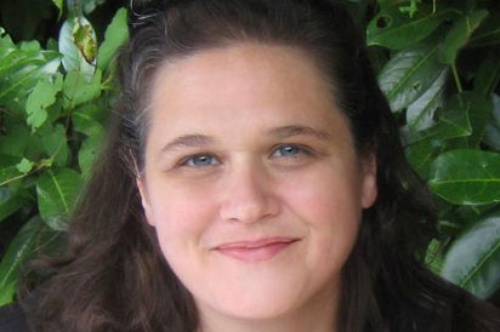
The SLS Interviews: Katrina Best
The Bird Eat Bird author on bad accents, the colour red and the Year of the Short Story.
Bird Eat Bird (Insomniac Press) is an impressive debut from a voice that will leave you in stitches. Katrina Best's stories marvel at the seemingly mundane; a middle aged couple's day at the beach or lunch in a London Park, and the reader is pulled below the surface and exposed to the quirky inner workings of some compelling characters. Her writing is sharp and witty, a great book to spend a warm day on the balcony with.
Best immigrated to Vancouver from the UK over fifteen years ago. She now lives in Montreal, where she writes fiction and also works as a screenwriter, story editor and script analyst for film and television. Bird Eat Bird won the 2011 Commonwealth Writers' Prize for Best First Book (Caribbean and Canada).
Larissa Andrusyshyn: The theme of consumption is a focal plot element in the collection, but there is also a significant amount of self-deception; both protagonists in "Red" and "Tall Food" have trouble reading how they are perceived by others. I think what makes the stories so successful is the way you balance humour and tragedy. What is your philosophy when it comes to those elements of storytelling?
Katrina Best: Well thank you, I'm glad you felt the balance was right. Certainly that was my intention throughout the collection—I tend to use humour when tackling serious subject matter, or exploring the human condition. The stories are supposed to be entertaining and funny, but yes, hopefully not only that. The two stories you refer to definitely share common ground in that the female protagonist in each is what you might call a little "off," and as you say, isn't able to properly gauge others' reactions to them, making them at once vulnerable and impervious to "normal" society and its rules. But "Red" very deliberately plays with the first person unreliable narrator device and is supposed to read, at least to begin with, almost like a stream of consciousness rant, while "Tall Food" is written in the third person limited.
LA: The stories take place on both sides of the Atlantic; some are set in Montreal and some in London, which makes for a delightful varied texture with a sprinkle of London vernacular in the opening story "Lunch Hour," or some Québécois French in "Red." How do you decide where to set a story? Does place play an important role in your stories?
KB: Actually it's an even split—three of the six stories are set in North America, three in Britain. That wasn't deliberate but it does perfectly represent my own duality and the fact that I consider both countries now to be home. I immigrated to Canada (Vancouver first, then Montreal) over fifteen years ago and have been a dual citizen for over twelve years now. I do think setting is important and I enjoy playing with accents, especially regional British ones, partly because I can still do them at readings (while my attempts at a convincing North American accent are still quite pitiful). "Red" is the only story set in Montreal and it felt important to reflect the mix of languages and cultures here. The émigré experience and attempting to integrate into an existing culture/community is also something I keep revisiting, for obvious reasons.
LA: I noticed an intriguing use of red throughout the book; each story features it with a visceral image: a fingernail, a tube of lipstick or the red snapper entrée on a doomed first date. How did this device come about?
KB: Certainly it was deliberate and important in the story actually titled "Red" (cut down from "Seeing Red")—that indeed contains many references to the colour starting with a false red fingernail dropping onto the street. But while I'd love to talk intelligently about the reason for the device elsewhere, I honestly hadn't quite noticed that it comes up in my other stories too! Thanks for spotting it. Funnily enough, a few years ago, when my children were really little, and around the time I started writing fiction seriously, they assigned me the colour red—"Red is Mummy's favourite colour," they announced one day, even though it really wasn't. But I guess it maybe stuck and became true!
LA: Many of the characters display quirks that make them memorable, like Patrick in "Tea Leaves," with his unusual use of the word "bom." Are your stories and characters inspired by your experiences with people you've met? How do your stories often begin?
KB: The story "Tea Leaves" does contain quite a few autobiographic elements and I originally approached it more as a personal essay or memoir piece, then later reworked it. The character of Patrick is based on a real guy I worked with a long time ago (all names were changed obviously!) and he really did say "bom" at the end of most sentences. What inspires me to write a story varies. I do draw from my own life and experiences, but can also get sparked by something I see, read or (over)hear. I remember in my early twenties sitting on top of a London bus and listening to two American tourists having (what they thought was) a serious conversation about a show they'd just seen, "Jason and His Amazing Technicolor Jacket." I suddenly felt compelled to write it all down and ended up scribbling all over the only thing in my bag, my chequebook. I now carry notebooks.
LA: Are short stories what you primarily write?
KB: As I mentioned, I only started seriously trying to write fiction a few years ago, after my two children were born. I think it might have a lot to do with lack of time and a shrinking attention span. I grew up reading novels primarily, and always thought I would one day attempt one. But when you have a toddler and a baby, there is little or no time to read, so I turned to short stories. If nothing else, I would read whatever story was in that week's New Yorker. Then I enrolled in an evening fiction class at the QWF, and that's where I wrote and workshopped my first story.
LA: Word on the street is that 2011 is the year of the short story, according to the YOSS manifesto but the publishing industry claims short story collections "don't sell well." Considering the success of your book and of other recent Canadian collections like Alexander MacLeod's Light Lifting, or fellow Insomniac Press author Mike Spry's Distillery Songs, do you think the genre is gaining an audience?
KB: Go YOSS! Yes I think it's a wonderful movement and I hope that it does mean more short story collections will get published and bought. But the industry wisdom still seems to say they don't sell as well. Yet as you say so many collections are doing well—in addition to the ones you mention there's the Giller-nominated This Cake Is For The Party by Sarah Selecky, and new Canadian collections that are getting great reviews and that I can't wait to read, such as And Also Sharks by Jessica Westhead, Up Up Up by Julie Booker and Better Living Through Plastic Explosives by Zsuzsi Gartner. This came up a lot recently at the Commonwealth Writers Prize finals in Sydney, Australia. Out of the four regional Commonwealth Prize best first book winners, two were short story collections-mine and A Man Melting by Craig Cliff, from New Zealand. Craig went on to win the overall prize for best first book, which is great for the short story and well deserved—it's a wonderful collection.
Larissa Andrusyshyn recently completed an MA in creative writing at Concordia University. She runs poetry workshops for youth in outreach schools and is a coordinator for the Paper Scissors reading series. Her work has appeared in CV2, Versal, Headlight, Running with Scissors (Cumulus Press), The Future Hygienic (Pistol Press) and Rogue Stimulus (Mansfield Press). Mammoth (DC Books) is her first poetry collection.
Montreal's Summer Literary Seminars take place from June 12 to June 25, 2011. For a schedule of events, or to buy a pass, visit www.sumlitsem.org/montreal/schedule.html
Subscribe to Maisonneuve today.
Related on maisonneuve.org:
—The SLS Interviews: Gary Shteyngart
—The SLS Interviews: Adam Levin
—The SLS Interviews: Lynne Tillman
Follow Maisonneuve on Twitter — Like Maisonneuve on Facebook






